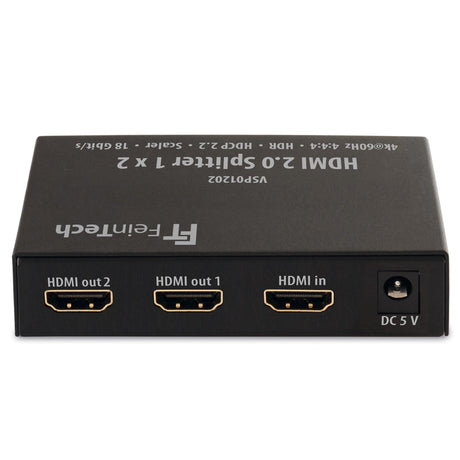This HDMI 2.0 splitter distributes an HDMI signal up to Ultra HD resolution (4K) to 2 HDMI end devices, e.g. televisions, monitors, projectors or AV receivers. The splitter is backward compatible with low input and output resolutions. If you connect a 4K source (e.g. UHD Blu-Ray player, Playstation 4 pro, Xbox One S/X, Apple TV 4K, Fire TV 4K or similar), you can operate 2 4K end devices simultaneously or alternately.

Special feature : 4K content can be displayed on a full HD display via an integrated down-scaler. This enables mixed operation of 4K TV and Full HD TV. If a 4K signal is present and both a 4K TV and a Full HD display are connected, the splitter delivers a downsampled 1080p image on the Full HD display. The refresh rate is not changed, 4K@60Hz becomes 1080p@60Hz. 4K is retained on the 4K television.
Full HD TVs do not support HDR (High Dynamic Range, high-contrast display), only SDR (Standard Dynamic Range). If such an SDR display is connected, the media player does not deliver HDR. As soon as an SDR end device is connected to the VSP01202, only SDR is output.

Audio EDID management
The splitter is ideal when a higher-quality audio format is to be played. Because the EDID for the audio format can be prioritized. The audio mode can be selected via a switch. This allows you to set the HDMI source to deliver the best possible sound format (maximum). If you connect a surround-capable device, you can force 5.1 sound, for example. 7.1 sound formats can also be output in this way, a television that can only process stereo naturally remains silent with 7.1 sound.
Instead, you can select the sound format that both connected HDMI end devices support (minimum). In minimum mode, the setting is such that both end devices can process the sound. Most of the time it's just stereo.

If the TV cannot process surround sound, the sound system can be supplied via HDMI.
Highlights of HDMI Splitter VSP01202:
- Distributes an Ultra HD HDMI signal (4K HDR) to 2 devices (TV, monitor, projector or AV receiver)
- Simultaneously output 4K on both outputs, or mixed output of 4K and 1080p
- Down-scaler for the simultaneous output of 4K content on a Full HD display (then no HDR)
- manual switching of the audio EDID via audio mode switch
Further data:
- Supports video formats up to 4096 x 2160 @ 60Hz YUV 4:4:4 including 3D
- Supports color format deep color 24 / 30 / 36 bit
- HDR (High Dynamic Range)
- Range with good standard HDMI cable 24AWG: at 1080p maximum 10 m at the entrance + 10 m at the exit, at 4K maximum 5 m at the entrance + 5 m at the exit
- Supported audio formats: DTS-HD Master Audio, DTS-HD High Resolution Audio, Dolby True-HD (incl. Atmos), Dolby Digital Plus, Dolby Digital (AC3), DTS, LPCM 7.1, stereo
- Supports HDMI-CEC control
- Delivery includes power supply unit, power consumption < 2W
- Dimensions 94 x 53 x 22mm
Addition 01/28/2019: Due to the many questions from users, we would like to give a few examples below of what does NOT work for technological reasons (see also the article on HDMI EDID data ) :
No HDR
Many media players will only output HDR if they detect that both devices support HDR. Therefore, if a 4k HDR and a Full-HD SDR device are powered on at the same time, only 4K SDR will be delivered by the media player. This can also happen when a 4K TV and Full HD AV Receiver are connected and powered on.
Solution: Either switch off the non-HDR-compatible end device if you want to watch HDR. Or use another media player that allows manual setting of HDR mode, eg FireTV Stick 4K.
Distorted colors or black levels in HDR on a Full HD TV
HDR signals are sometimes not displayed correctly on Full HD devices. The color space is larger. A conversion from HDR to SDR is not planned. Full HD devices "know" no HDR. Therefore, SDR should be selected if you want to watch on a Full HD TV. Dynamic HDR formats such as Dolby Vision or HDR10+ are displayed completely distorted on the SDR screen.
No 7.1 sound
Some 7.1 surround systems cannot process a signal with HDR because they do not know this format and the data rate is too high. It is of no use if the downscaler calculates down to 1080p, but HDR is still output. 7.1 sound is then only possible with SDR images. Our remedy HD Audio Extractor .
No extended desktop on the PC
A splitter distributes the incoming signal to 2 monitors. Both receive the same image – even with a computer as the signal source (“mirroring”). It is therefore not possible to display an extended desktop with 2 different image contents ("extended desktop"). This requires two graphics card outputs on the PC.





